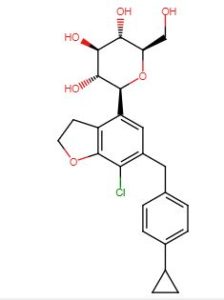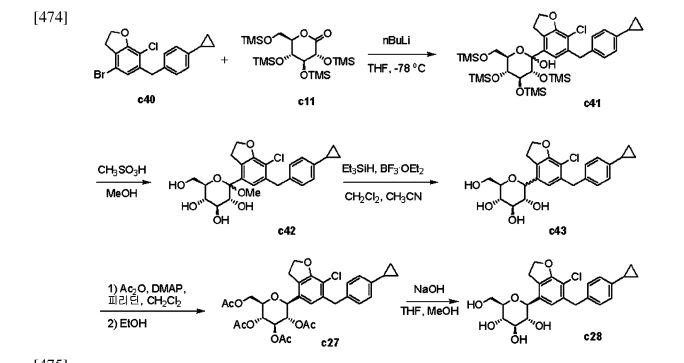



Enavogliflozin, DWP-16001
(2S,3R,4R,5S,6R)-2-(7-chloro-6-(4-cyclopropylbenzyl)-2,3-dihydrobenzofuran-4-yl)-6-(hydroxymethyl)tetrahydro-2H-pyran-3,4,5-triol
(2S,3R,4R,5S,6R)-2-(7-chloro-6-(4-cyclopropylbenzyl)-2,3-dihydrobenzofuran-4-yl)-6-(hydroxymethyl)tetrahydro-2H-pyran-3,4,5-triol
CAS: 1415472-28-4
Chemical Formula: C24H27ClO6
Molecular Weight: 446.92
Elemental Analysis: C, 64.50; H, 6.09; Cl, 7.93; O, 21.48
Green Cross Corp INNOVATOR
Daewoong Pharmaceutical Co Ltd
Enavogliflozin is an antidiabetic (hypoglycemic).
Daewoong is investigating DWJ-304 , a sodium/glucose cotransporter 2 (SGLT-2) inhibitor, for treating type 2 diabetes. By February 2017, preclinical development was underway. Daewoong is developing DWP-16001 , presumed to be enavogliflozin, a SGLT-2 inhibitor, for treating type 2 diabetes. In September 2019, launch was expected in 2023.
PATENT
WO2012165914
DWP-16001 expire in EU states until June 2032 and US in November 2033.
PATENT
US 2014274918
PATENT
US2019169174
Paragraph 0305; 0340; 0347
H NMR (400 MHz, CD3OD) δ 7.02 (d, J=8.0 Hz, 2H), 6.92 (d, J=8.0 Hz, 2H), 6.81 (s, 1H), 4.59 (t, J=8.8 Hz, 2H), 4.11 (d, J=9.2 Hz, 1H), 3.96 (ABq, ΔvAB=19.0 Hz, JAB=15.2 Hz, 2H), 3.87-3.84 (m, 1H), 3.67-3.63 (m, 1H), 3.47-3.37 (m, 3H), 3.35-3.33 (m, 3H), 1.85-1.79 (m, 1H), 0.91-0.86 (m, 2H), 0.61-0.57 (m, 2H)
PATENT
WO2017217792 , claiming process for preparing diphenylmethane derivative.
https://patentscope.wipo.int/search/en/detail.jsf?docId=WO2017217792&tab=FULLTEXT&_cid=P21-K72SDW-38338-1






1H NMR(400 MHz, CD 3OD) δ 7.02(d, J = 8.0 Hz, 2H), 6.92(d, J = 8.0 Hz, 2H), 6.81(s, 1H), 4.59(t, J = 8.8 Hz, 2H), 4.11(d, J = 9.2 Hz, 1H), 3.96(ABq, Δv AB = 19.0 Hz, J AB = 15.2 Hz, 2H), 3.87-3.84(m, 1H), 3.67-3.63(m, 1H), 3.47-3.37(m, 3H), 3.35-3.33(m, 3H), 1.85-1.79(m, 1H), 0.91-0.86(m, 2H), 0.61-0.57(m, 2H); [M+Na] + 469.
PATENT
WO-2020036382
The present invention relates to a method for producing an intermediate useful for the synthesis of a diphenylmethane derivative that can be used as a SGLT inhibitor. A method for synthesizing a compound of formula 7 according to the present invention has solved the problem of an existing synthesis process which requires an additional process due to the synthesis of Grignard reagent and the management of a related substance. In addition, the process can be simplified by minimizing the formation of the related substance and eliminating the need for reprocessing of reaction products, thereby becoming capable of maximizing a yield of a diphenylmethane derivative.
Process for preparing intermediates of SGLT inhibitor and their use for the synthesis of diphenyl-methane derivative, which can be used as SGLT inhibitors.
Sodium-dependent glucose cotransporters (SGLT) allow the transport of Na + along the concentration gradient simultaneously with the transport of glucose across the concentration gradient. Currently two important SGLT isoforms have been cloned, known as SGLT1 and SGLT2. SGLT1 is located in the intestine, kidney and heart and regulates cardiac glucose transport. SGLT1 is a high affinity low dose transporter and therefore only accounts for a portion of renal glucose reuptake. In contrast, SGLT2 is a low affinity, high dose transporter located primarily in the apica domain of epithelial cells in the early proximal manure tubules. In healthy individuals, over 99% of the plasma glucose filtered out of the renal glomeruli is reabsorbed and less than 1% of the total filtered glucose is excreted in the urine. It is estimated that 90% of renal glucose reuptake is promoted by SGLT2 and the remaining 10% is mediated by SGLT1 in the late proximal canal. Genetic mutations in SGLT2 do not have a particular adverse effect on carbohydrate metabolism but cause increased kidney glucose secretion of about 140 g / day following mutation. Human mutation studies have been the subject of therapeutic studies because SGLT2 is believed to be responsible for most renal glucose resorption.
[3]
Korean Unexamined Patent Publication No. 2017-0142904 discloses a method for producing a diphenylmethane derivative having inhibitory activity against SGLT2. Since the above document prepares diphenylmethane derivatives by a convergent synthesis method in which each group is individually synthesized and then coupled, the synthesis route is more concise and yield is higher than the linear synthesis method disclosed in the prior art. It is disclosed that it can increase and reduce the risks inherent in sequential synthesis pathways.
[4]
However, the preparation method of the diphenylmethane derivative according to Korean Patent Publication No. 2017-0142904 uses a heavy metal such as pyridinium chlorochromate (PCC) to burden safety management, and the Grignard reagent. In addition to the need for a separate manufacturing process, the cost of the additional process is not only incurred, but also the management of the flexible material is necessary because the flexible material from the Grignard reagent manufacturing process is included in the final product. In addition, since the product generated after the reaction between the intermediate and the Grignard reagent includes additional flexible materials, there is a problem that a reprocessing process of such flexible materials is required.
Step 3. 4- bromo- 7- chloro -6- (4- cyclopropylbenzyl ) -2,3- dihydrobenzofuran (Compound 6)
(4-bromo-7-chloro-2,3-dihydrobenzofuran-6-yl) (4-cyclopropylphenyl) methanone (Compound 5) in a mixture of dichloromethane (9.7 mL) and acetonitrile (9.7 mL) at -15 ° C. g, 2.57 mmol) was added Et 3 SiH (1.2 mL, 7.71 mmol) and BF 3 -Et 2 O (0.79 mL, 6.42 mmol) in this order. The reaction mixture was allowed to warm to room temperature and then stirred for 4 hours. After completion of the reaction by TLC, the reaction solution was added with saturated NaHCO 3aqueous solution (40 mL) to terminate the reaction, and extracted with ethyl acetate. The organic layer obtained by extraction was dried over anhydrous magnesium sulfate, filtered and concentrated in vacuo. The concentrated residue was purified by silica gel chromatography to give the title compound 6 (0.84 g, 89.9%) as an off-white solid.
[387]
1 H NMR (500 MHz, CDCl 3): δ 7.07 (d, J = 10.0 Hz, 2H), 6.99 (d, J = 10.0 Hz, 2H), 6.80 (s, 1H), 4.70 (t, J = 11.0 Hz , 2H), 3.97 (s, 2H), 3.26 (t, J = 11.0 Hz, 2H), 1.88-1.84 (m, 1H), 0.95-0.90 (m, 2H), 0.68-0.64 (m, 2H); LC-MS: [M + H] & lt; + & gt; 363.
REFERENCES
1: Markiewicz M, Jungnickel C, Stolte S, Białk-Bielińska A, Kumirska J, Mrozik W. Ultimate biodegradability and ecotoxicity of orally administered antidiabetic drugs. J Hazard Mater. 2017 Jul 5;333:154-161. doi: 10.1016/j.jhazmat.2017.03.030. Epub 2017 Mar 16. PubMed PMID: 28349868.
2: Holt RI. Trials of new anti-diabetes agents. Diabet Med. 2017 Feb;34(2):147. doi: 10.1111/dme.13306. PubMed PMID: 28090726.
/////// DWJ-304, Daewoong Pharmaceutical, DWP-16001, SGLT-2 inhibitor, type 2 diabetes, KOREA, Enavogliflozin
ClC1=C2C(CCO2)=C([C@@H]3O[C@H](CO)[C@@H](O)[C@H](O)[C@H]3O)C=C1CC4=CC=C(C5CC5)C=C4

























